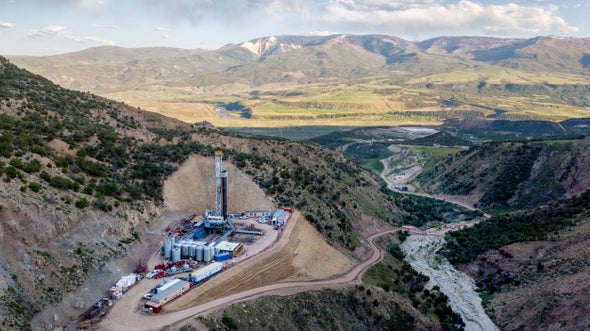Methane Is on an Alarming Upward Trend
Atmospheric concentrations of the second most important greenhouse gas are hitting record levels

Cows, oil and gas wells, rice paddies, landfills. These are some of the biggest sources of methane staining the atmosphere today. Methane is the most important greenhouse gas after carbon dioxide, and its concentration reached a record 1,875 parts per billion (ppb) last year, more than two and a half times preindustrial levels. Peak methane in the atmosphere feels as elusive as a cure for the (next) coronavirus.
As scientists at the Global Carbon Project, we and dozens of our colleagues just published a four-year study and public data sets of the Global Methane Budget to estimate methane sources from land, oceans, agriculture and fossil fuel use. Methane emissions reached a record 596 million metric tons per year (range of 572–614 million tons including error estimates) in 2017, the last year for which data are fully available. We present the results in the journals Earth System Science Data and Environmental Research Letters.
More than half of global methane emissions come from human activities, primarily agriculture and fossil fuel use. Our estimate for 2017 is up about 50 million tons, or 9 percent, compared to annual methane emissions in the early 2000s. Convert those 50 million extra tons of methane each year to the warming potential of carbon dioxide over the next century, and we’ve added the equivalent of 350 million more cars to the world’s roads—or another Germany and France to the world’s emitters.
The concentration of methane in the atmosphere is tracking trajectories modeled in aggressive warming scenarios where global temperatures rise by three to four degrees Celsius this century. With each passing year, we move further away from the pathways that climate models suggest will hold warming below 1.5 or two degrees C. In many ways we’re even further from reducing methane emissions than we are for carbon dioxide.
Biological sources of methane arise primarily from microbes growing in low-oxygen environments, including natural wetlands, landfills, water-logged rice paddies and the stomachs of ruminant cows, goats and sheep. We don’t find evidence for increased methane emissions from natural wetlands, but we do from landfills and ruminants through 2017; there are a billion and a half more people on earth today than in the year 2000, and average red meat consumption per person is still increasing. Agriculture contributes about two thirds of all methane released from human actions—as much as all natural sources combined.
Natural seeps, such as bubbling mud volcanoes, release some methane from fossil sources underground. But most fossil geologic methane making its way to the atmosphere comes from fossil fuels we extract, transport or burn. After agriculture’s two-thirds contribution, fossil fuel activities contribute most of the remaining third of global methane emissions from human actions—from coal mines and oil and gas wells to leaky natural gas pipelines and kitchen stoves. Overall, emissions from agriculture and fossil fuel use contributed equally to the 50-million-ton annual increase we observed.
Where have methane emissions increased the most since 2000? Three broad regions—Africa and the Middle East; China; and South Asia and Oceania—saw the biggest annual increases, at 10 million or more tons of methane each. Increases in Africa and southern Asia arose primarily from greater agricultural activities. China’s growth came mostly from greater fossil fuel use. The same was true in North America, where methane emissions increased an estimated five million tons per year in the United States from increased oil and natural gas extraction and use.
We looked closely at the Arctic to see if methane emissions were increasing. From bubbling oceans to thawing permafrost, the specter of runaway methane release has captured public attention as a potential climate “tipping point.” The concern comes from hints that rapid methane release 55 million years ago at the boundary between the Paleocene and Eocene epochs triggered global temperature increases of five to eight degrees C globally. Through 2017, at least, we see no evidence for any increase in Arctic methane emissions. Instead, the increased emissions we document since 2000 appear to have occurred in temperate and tropical systems.
The one region where methane emissions have decreased over the last few decades is Europe. Policies and better management there have helped reduce emissions from landfills, manure and other sources. Cattle numbers in Europe have also declined since 2000 as people eat less beef and more poultry and fish in their diets.
Curbing emissions worldwide from half a billion goats and more than a billion cattle and sheep each won’t be easy. Some answers include better manure management, as Europe has done, eating less meat (for those of us with enough protein in our diets) and adding feed supplements like algae or essential oils to reduce methane burps in cattle and sheep. We can alter rice farming to avoid the permanent waterlogging that boosts methane production. We can reduce fugitive methane escaping as we mine, distribute and use oil, natural gas and coal. We can also use less fossil fuels by adopting low-carbon renewables, electric vehicles and energy-efficient technologies. If we don’t do all of these things, methane emissions will keep rising and warming the planet, perhaps requiring more expensive and less proven technologies for methane removal after release.
Methane is a colorless, odorless and extremely potent greenhouse gas, far more potent than the same amount of carbon dioxide. Methane also contributes to near-surface ozone pollution that harms our health and hurts crop production. While carbon dioxide rightfully gets the most attention because it causes the most warming, options to reduce methane emissions are also important, as society seeks ways to approach zero emissions for both gases to stabilize the earth’s temperature. Right now, methane keeps bubbling away.https://www.scientificamerican.com/article/methane-is-on-an-alarming-upward-trend/

